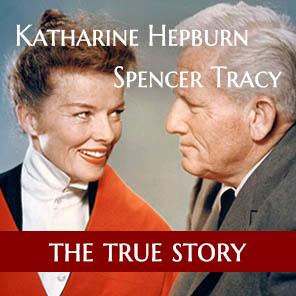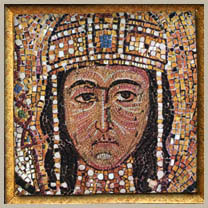Is Scotty Bowers, the famous Hollywood pimp telling the truth about Spencer Tracy and Katharine Hepburn? Here's a confirming story...
Serving Breakfast, English Fashion
 Table laid for Breakfast, English Style, showing Meat Course.
Table laid for Breakfast, English Style, showing Meat Course.
REPRESENTATIVE BREAKFAST MENU
Grapes.
Cream of Wheat. Cream. Sugar.
Hamburg Steak in Cakes. Baked Potatoes.
Cold Bread. Hot Muffins.
Butter. Coffee. Milk, Hot and Cold. Marmalade.
The above menu provides food for a family of adults and children, and fairly represents an American breakfast. We will suppose that it is to be served English fashion, from the table. First let us notice the "laying of the table." Over the polished top of the table spread a heavy cover of felt, double-faced Canton flannel, or some similar material. Fasten this securely about the table legs, that it may not slide about upon the polished surface. This cover will protect the table top, deaden the sound made in setting down china, etc., and improve the appearance of even the finest linen. Over this cover spread the damask cloth, having the fold of the cloth exactly in the centre of the table with opposite edges of the cloth at uniform distances from the floor.
At the centre of the table place a dish of fruit, a growing plant, or cut flowers. The plate, napkins, glasses, and cutlery set in place for each individual at the beginning of a meal are designated " the cover." The plate, of breakfast size, and the cutlery are set half an inch from the edge of the table. The decorations of the plate should face the sitter at the table. At the right of the plate and near it lay a knife, the cutting edge towards the plate. At the right of the knife lay a dessert spoon for the cereal. On the left of the plate lay a fork of breakfast size with tines turned upward. At the point of the knife set a tumbler of water, and beside it another for milk. At the point of the fork set a small plate for bread, hot muffins, and butter, and across this lay a small knife or "spreader." At the left of the fork lay a napkin, above the plate a dessert spoon, above this a fruit napkin with a finger-bowl beside it. Between each two covers dispose salt and pepper sets, also carafes for water.
The end of the table (side if round) farthest from the drawing-room door is the head of the table. The opposite end is the foot of the table. The reason is obvious, when we think that the host enters the dining-room first and the hostess leaves it first.
Above the cover at the foot of the table set out the required number of coffee cups and saucers, a large tray often holds the whole coffee service and the dishes belonging to " the cover." Near these dispose coffee spoons on a flat dish, the cream-jug, and a bowl of cut sugar. In front of these place, if needed, stands for hot milk and coffee.
If the breakfast or luncheon is served on the polished table top, and in the English fashion, it will be necessary to place several thicknesses of asbestos paper under the tray cloths on wich platters are laid, to preserve the table from stains from the the heated dishes.
Place the chairs for the company, with the edge of the chair in a line with the edge of the table, to make it easier for each one to be seated.Where a joint has to be carved at the table, a carver's chair, some inches higher than the others, is placed for the host.
 ANNOUNCING THE BREAKFAST
ANNOUNCING THE BREAKFAST
Where great formality is observed it is customary to knock at bedroom door of each member of the family and at the doors of the guests, to announce breakfast.Otherwise a Japanese or other form of musical gong may be used; but even where gong summons members of the family it is more courteous to guests to notify them individually.
The family now being seated at table:
- Set the dish of grapes before the head of the table, and lay the grape shears beside the dish.
- Bring in each hand a plate from the sideboard, and set one down between "the cover" and the grape dish.
- When it has been made ready, take it up and set down the second plate.
- Put the filled plate down, from the right, upon the breakfast plate of the one for whom it was made ready, and, taking another plate from the sideboard, return to the head of the table.
- Take up the prepared plate and set down the other, and so continue until all have been served. When this course has been finished, take out, first, the dish of grapes, then, setting the finger-bowl upon the fruit plate, take out plate, bowl, and spoon together, one set in each hand.
Now bring in the cereal in a covered dish on a tray. Set the dish down before the head of the table, a tablespoon at the right of it. Remove the cover, reverse it, to avoid drops of water (condensed steam), and take it on the tray to the serving-table or pantry. Return with sugar and cream (if these were not in place at the beginning of the meal), then return with a cereal dish or saucer in each hand or on a tray. Set one down between "the cover" and the cereal dish, and when it is made ready (with cream and sugar as desired), replace it with the second dish, and carry to him or her for whom it was prepared, setting it down at the right.
Individual preferences and the time that can be given to serving and clearing away a meal have to be considered in connection with many points of table management. Many prefer that the cereal dish be presented upon a breakfast plate, and that both together be substituted for the plate in "the cover" This calls for more dish washing; but it has its advantages, especially when the cereal has been creamed. In either case, the waitress or the server may lift the dish to the tray, according to preference. The cereal course finished, the cereal dish is first removed, then the sugar and cream, and, lastly, the individual dishes, one in each hand, or two side by side on a tray. All piling of dishes is to be avoided, in any case.
Now replenish the glasses with water, and pour milk for those who desire it. Set the platter of Hamburg cakes and the dish of potatoes before the head of the table. Lay a small carving knife at the right of the platter, a table-spoon beyond and nearer the platter, a carving fork at the left of the platter, and a fork at the right of the potato dish. Set the dish of hot muffins on the table. Bring two warmed plates. Set down one between the meat platter and the cover. When filled, take up with the right hand, set down the plate in the left hand, and carry the filled plate to the foot of the table. Take back a plate in the left hand, and substitute it for the plate made ready to serve. Set this down before the one next in order, and in this manner serve all upon one side of the table and then those upon the other side. Pass the muffins and the bread. Supply butter, if needed. When the coffee is ready, set the cups down at the right of those for whom they are especially prepared. Pass the marmalade to the left, that those who wish it may help themselves. The marmalade may be placed on the bread-and-butter plate or on the breakfast plate.
The waitress has now more opportunity to look about and see what is needed by any one; and butter, muffins, bread, or the potato dish, may be passed to the left of those in need, that each may help himself. Keep the glasses supplied with milk and water.
Luncheon and dinner are served after the same general plan. At dinner, the roast and fish are served from the head of the table, and the soup, salad, and sweet course from the opposite end of the table. The same holds good at luncheon, save that a roast is not given place in the menu.
POINTS TO BE REMEMBERED IN SERVING ALL MEALS
- The room must be in order, clean, free from dust, and well aired. The temperature should be about 7o0F.
- The linen should be immaculate, the china and glass glistening, and the silver well polished.
- The plate marks the centre of each cover.
- Allow at least twenty-five inches in length thirty is preferable for an individual " cover " at table.
- Allow fifteen or sixteen inches in depth for the " covers "; i. e.y all glasses, plates, etc., are to be set inside of an imaginary line fifteen or sixteen inches from the edge of the table.
- Knives are placed at the right, forks to the left of the plate; the cutting edges of knives are towards the plate, the tines of the forks and bowls of spoons are turned upwards.
- Plates, knives, forks, and spoons are set half an inch from the edge of the table, and are disposed in the order of use, the first used farthest from the plate.
- In passing a tray to the left for a guest to help himself let the tray be held low enough to be reached with ease.
- When one at table is to help himself from a dish, as of vegetables, passed by the waitress, before the dish is passed the waitress puts the spoon into the dish in such a manner that, a spoonful can be readily taken out. If the dish be a salad, the spoon is set in the dish at the right and the fork at the left.
- Warm all dishes for hot foods and chill those for cold food. To warm, rinse in hot water and dry, or set into the warming oven.
- Fill the glasses with water and set butter in place the last thing before announcing that meals are served.
- Fresh knives and forks should not be put on the table during a course, nor laid on the clean plate to be set down before one at table.
POINTS TO BE REMEMBERED IN SERVING MEALS AFTER THE ENGLISH STYLE
- The food is served from the table.
- Save relishes, bread and butter, and such articles as pertain alike to all courses up to the sweet course, only one course appears at a time upon the table.
- Pass all dishes, from which food is to be taken, to the left of those at the table.
- Set all portions at the right of the individual for whom they are prepared.
- Everything pertaining to one course must be removed before serving another course.
- In clearing the table for another course:
Remove food.
Remove soiled china, glass, and silver.
Remove clean china, glass, and silver pertaining to the courses served.
7. In clearing the table for the sweet course, remove as above, including under food, bread, butter, and relishes, then (4) free the table from crumbs, using silver implements for a table covered with damask, a napkin and plate when the meal is served on the polished table top.
8. In clearing the table after the carving of meat, first remove the carving knife and fork with gravy spoon upon a tray, taking care that each lies separately on the tray.




